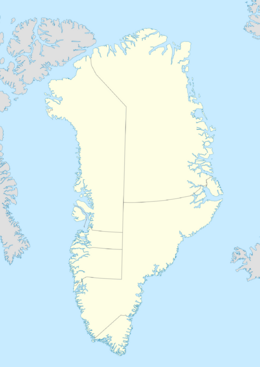Earth:Kaffeklubben Island
| Native name: Inuit Qeqertaat | |
|---|---|
 Aerial photograph of Kaffeklubben Island taken on September 29, 2008 | |
| Geography | |
| Location | Greenland |
| Coordinates | [ ⚑ ] : 83°39′45″N 30°36′50″W / 83.6625°N 30.61389°W |
| Administration | |
| Northeast Greenland National Park | |
| Demographics | |
| Population | Uninhabited |
| Additional information | |
| Time zone |
|
Kaffeklubben Island or Coffee Club Island (Danish: Kaffeklubben Ø; Greenlandic: Inuit Qeqertaat) is an uninhabited island lying off the northern shore of Greenland. It contains the northernmost undisputed point of land on Earth.
History
Kaffeklubben Island does not appear to have ever been inhabited. The nearest ruins from the Independence I culture are located at Cape Bridgman, some 80 km (50 mi) to the southeast. Whether members of the culture ever went to the island or its vicinity is unknown. In any event, the culture disappeared after around 1900 BCE, and the northern part of Peary Land – known as Johannes J. Jensen Land – has remained uninhabited ever since.
The first recorded sighting of Kaffeklubben Island was made by the American explorer Robert Peary in 1900, who believed that Cape Morris Jesup on the mainland was the world's northernmost point of land and who declined to name the island. The island itself was not visited until 1921, when the Danish explorer Lauge Koch set foot on the island and named it after the coffee club in the University of Copenhagen Geological Museum.
In 1969, a Canadian team calculated that the island's northernmost tip is 750 metres (2,460 ft) farther north than Cape Morris Jesup, the northernmost point of mainland Greenland, thus claiming its record as the most northerly point of land.
Other claimants for northernmost land
Since its record as the northernmost point of land was established, several gravel banks have been discovered in the sea to the north of the island, such as Oodaaq, 83-42, and ATOW1996; however, there is debate as to whether such gravel banks should be considered for the record since they rarely are permanent, being swallowed regularly by the moving ice sheets, being shifted in tides, or becoming submerged in the ocean.
Geography and geology
Kaffeklubben Island is 713.5 kilometres (443.3 mi) from the geographic North Pole. The island lies off Cape James Hill, 10 kilometres (6.2 mi) northwest of Bliss Bay,[1] approximately 37 kilometres (23 mi) east of Cape Morris Jesup, a little east of a central point along the northern coast of Greenland. Its most northerly point is 4.4 km north of that of Cape Morris Jesup. It is approximately 700 metres (2,300 ft) long,[2] and approximately 300 metres (980 ft) across at its widest point. The highest point is approximately 30 metres (98 ft) above sea level.[2]
Flora and fauna
Despite the harsh environment, vegetation grows on Kaffeklubben island, including various mosses, liverworts, lichens, and the flowering plants: Saxifraga oppositifolia (purple saxifrage) and Papaver radicatum (arctic poppy).[3][4][5][6]
Lake
Despite its small size, the island contains a lake, known as Kaffeklubben Sø. Kaffeklubben Sø has been described as the world's most northerly lake,[7][8] and was formed about 3,500 years ago when glacial retreat allowed rain to collect as a lake.[7]
See also
- List of islands of Greenland
- ATOW1996, a gravel bank with a disputed claim as the most northerly land area
- 83-42, a gravel bank with a disputed claim as northernmost point of land
- List of northernmost items
References
- ↑ "Oodaap Qeqertaa". Mapcarta. https://mapcarta.com/19198038.
- ↑ 2.0 2.1 Funder, S. V. E. N. D.; Larsen, O. (Nov 15, 1982). "Implications of volcanic erratics in Quaternary deposits of North Greenland". Bulletin of the Geological Society of Denmark 31: 57–61. ISSN 0011-6297. https://www.researchgate.net/publication/237480811. Retrieved August 23, 2014.
- ↑ Arctic Thule. "Kaffeklubben – Top of the World?". http://www.arcticthule.com/about/kaffeklubben.
- ↑ "The Flowers of Kaffeklubben Island". http://www.atlasobscura.com/places/the-flowers-of-kaffeklubben-island.
- ↑ "Pax Arctica". http://www.paxarctica.org/Greenland_2008_PV.html.
- ↑ "Template". http://www.sagaxexpeditions.com/2US%20-%203.4%20Photos-Videos.html.
- ↑ 7.0 7.1 Hecht, Jeff (4 October 2012). "World's most northerly lake comes back to life". New Scientist. https://www.newscientist.com/article/dn22337-worlds-most-northerly-lake-comes-back-to-life/. Retrieved 25 April 2019.
- ↑ Andries, Kate (19 October 2012). "Northernmost Lake Resurrected Due to Warming". National Geographic. https://www.nationalgeographic.com/science/article/121017-northernmost-lake-greenland-global-warming-science-environment. Retrieved 25 April 2019.
 |



